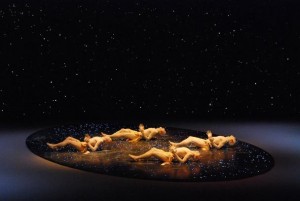Life, Death, and Back Again
Imagine sitting in the Joyce Theater and watching your life flash before you. One of Japan’s most successful Butoh dance companies, Sankai Juku, along with Director Ushio Amagatsu, attempts to depict “the cosmos of life” in their recent work, Tobari – As if in an Inexhaustible Flux. The goal of the performance is to show the people of the world going through life, death, and rebirth, using evocative imagery. The word ‘tobari,’ in Japanese, means “a border between day and night.” Amagatsu depicts this border throughout the piece. From the opening scene, we notice the reoccurring themes of light, darkness, simplicity, life, and death. The entire dance has almost a dreamlike feel, like your watching something in slow motion.
All the dancers are male and also curiously, bald. They are each dressed with minimal costumes. Some wear an orange short skirt that leaves almost their entire torso uncovered, some wear a skin colored body garment that leaves their arms uncovered, and some wear a blackish-purple robe that appears to be a silk-like texture. These dancers are also completely painted or powdered white from head to toe. The music is slow and eerie, creating a suspenseful sound. The little scenery that is present is extremely basic, yet it conveys just the right idea. It consists of a large glossy black oval shaped mat placed on the floor directly in the center of the stage, and a jet-black backdrop with thousands of stars printed on it. Sand is also placed all over the stage floor, leaving the dancers footprints temporarily fixed in the ground and in our minds. The sand sends us the message that we are born from the dust and that we shall also go back to the dust with our death. The music, composed by Sankai Juku regulars Takashi Kako, Yas-Kaz and Yoichiro Yoshikawa, complemented by the austere scenery, gives you the feeling that you are in the middle of a boundless space. Amagatsu later said in an interview, “My dance is based on that of sympathizing or synchronizing with gravity. The movement comes from how the dancers respond to the environment they are existing within. It’s about feeling the air and its vibration around them; we can call it a dialogue with air.”1 The dancers are feeling their surroundings and responding to the surroundings with their dance moves. It is almost like a conversation between the dancers and their surroundings, but instead of words the language used is dance.
The cast, consisting of seven male dancers, appeared often on the stage in groups of three or four. They glided across the stage with grace and poise as they executed challenging stretches and intricate body movements. Their aptitude was obvious to me from the beginning of the piece, since the dancers appeared more like rubber toys than human beings. The bald and painted men go from laying down to standing up almost effortlessly, and switch positions constantly. At one point a few of the men walked across the stage, and the rest of the dancers fell to ground, as if a wind or a wave had just hit them. However, the busiest parts of the dancers’ bodies were their hands. They constantly open and close their palms, as well as move their hands and arms in unique ways. At one point, the dancers pretend to grab items from around them, such as invisible bugs, and this produces a pantomime effect. They didn’t utter a sound during the performance either, and when Amagatsu stood at the front of the stage and “yelled” to the audience toward the end of the dance it was as if a mute button was on. There was a sense of pain and anguish, but this was conveyed without the use of words or moans.
One negative flaw of the dance was that the dancers’ movements were controlled by the music, as opposed to their innate feelings. They were one with the music, and it conducted them throughout the piece. This restricted the dancers’ choice of movements, and marred the dance. The themes of life, death, and rebirth, were attention grabbing, however they were hard to encounter in this dance. The sudden appearances and disappearances of the dancers, along with the sudden darkness and light, were the only references to the message of life and death. It projected the idea that death is sudden, and that the life does not last forever. There is also no intermission during this piece, showing us that there is no break in time throughout life. Time will always go on, and night will always come after day, no matter how badly we wish otherwise.
The stage lighting, specifically the contrast of light and darkness, was done really well. The dark and starry backdrop, along with the black glossy oval in the middle of the stage set the dark mood. The painted dancers, and the white sand provided the perfect contrast against the black scenery, and even made the stage look extremely pleasing to the eye. Astonishingly, the intimate setting of The Joyce Theatre made the performance even more spectacular, because although the stage was smaller it didn’t feel that way due to the lighting and stage setup. With Tobari Amagatsu proved that simplicity could be the new complexity.
Sankai Juku continues through Oct. 17 at the Joyce Theater, 175 Eighth Avenue, at 19th Street, Chelsea; (212) 242-0800, joyce.org.
1. Reiter, Susan. “Japan Takes Chelsea.” New York Press 30 Sep 2010: n. pag. Web. 6 Oct 2010. <http://www.nypress.com/article-21689-japan-takes-chelsea.html>.
